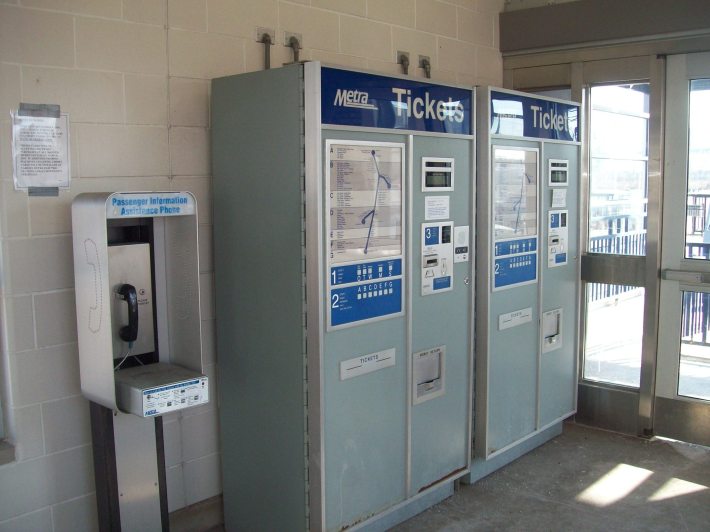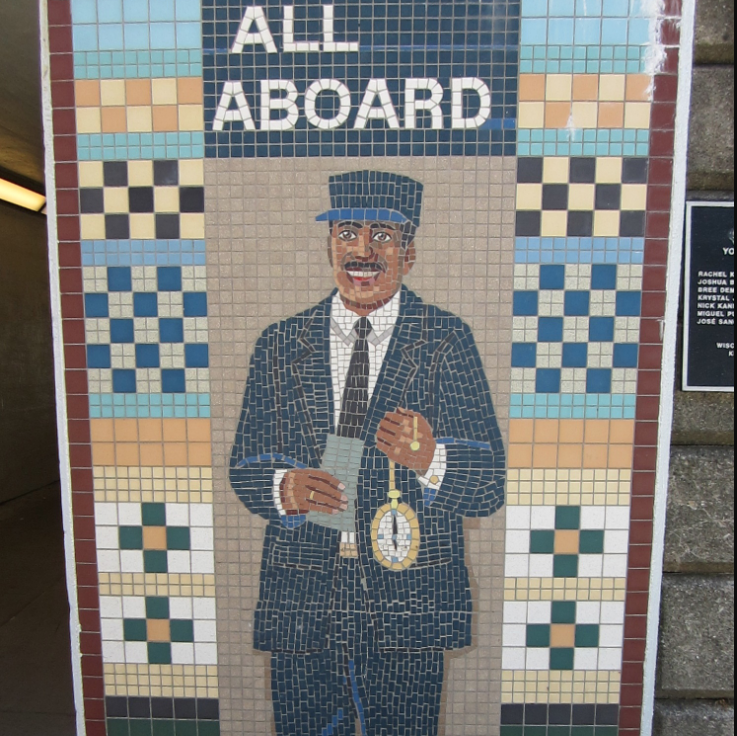Update 1/21/20: The Active Transportation Alliance published a letter in the Sun-Times yesterday arguing using Metra Police to enforce fare payment would be a waste of money, since there were only 46 arrests for fare evasion on Metra trains between 2016 and 2018. "What’s more, fare evaders are often low-income people of color — people who are often in their position due to institutionalized racism and systemic poverty rather than because they are bad actors."
Update 2/4/20: A Metra spokesperson clarified that, contrary to what was stated in the Active Trans letter and its headline, "We did not say we were hiring more police to check fares... What we said was that we would occasionally use Metra police to check tickets."
In recent years, onboard Metra fare collection has been strikingly hit-or-miss. In some cases, it has seemed like passengers have had to go out of their way to get the conductor's attention in order to do the right thing by paying their way. In 2011 the railroad went as far as to launch the "Be Fair, Pay the Fare" campaign, basically pleading with riders not to take advantage of how easy fare evasion is on the system.
However, things may be changing in the future. Over the next few months, Metra will consider new strategies for improving fare collection. Some of the ideas being floated could significantly change the way Metra ticketing works.
As noted during Metra's January 15 board meeting, the system's fare collection problem is something that many U.S. commuter rail systems share. While CTA ‘L’ stations have turnstiles and CTA and Pace buses have single-door boarding supervised by the driver, most Metra stations are designed to let passengers board as quickly as possible, through the doors of as many cars as possible. Therefore, the railroad depends on conductors to ask riders for tickets, which becomes challenging when trains get crowded.
In recent months, Metra staff looked at peer systems to see what how they're addressing this challenge. The ideas presented during the board meeting include requiring riders to tap on and tap off at stations with a fare card; putting in gates at major terminals; installing ticket machines at all stations; and investing in equipment that would allow conductors to sell tickets and issue fines on the spot.
While it will be at least a few more months before Metra takes any concrete actions toward larger-scale changes, it is currently taking smaller steps to address the issue. These include putting up signs on trains and in stations warning customers about the consequences of evading fares, and having Metra Police officers help conductors with fare collection.
Recently Metra has been leaving fliers on train seats with a stern warning (some have argued overly-so) for would-be fare evaders. Here's a passage from the note:
Customers are expected to have the appropriate fare to ride our trains – meaning they have a ticket that reflects they paid the correct amount for the trip they are taking. If a customer does not produce a paper or mobile ticket or refuses to pay for their fare on board with cash or via the Ventra app, Metra may remove that customer from the train and police may issue citations for state and/or county offenses.
“Metra Police occasionally will complement the efforts of conductors to validate fare collection, checking customers to make sure they have an appropriate ticket,” said Metra spokesperson Michael Gillis. “At first, this will be an educational effort, but it will eventually transition to warnings, and then citations.”
David Rubino, Metra’s director of station services, said that there are several factors that hinder fare collection. Every single ticket needs to be checked and, in the case of single-ride and 10-ride tickets, hole-punched. Buying tickets with cash on the train slows down the ticket-checking, and large crowds make checking and collecting tickets difficult.
Jim Derwinski, Metra’s executive director, discussed the issue of “zone-jumping,” when a rider buys a ticket that's only valid for, say, fare zones A-C, but continues riding until fare zone F. A conductor may check the ticket after the passenger boards and not notice when the rider stays on the train for a longer trip than what they paid for.
Derwinski framed cracking down on fare evasion as a financial necessity. For this year’s budget, Metra was able to avoid fare increases by reducing administrative expenses and leaving several positions vacant, he said. But he emphasized that he wasn’t sure the transit agency would be able to do anything like that next year. “With tax revenue coming in low and fare revenue coming in low, there are no more levers to pull."
Rubino said that he and Jeff Brantz, Metra’s business systems analysis manager, traveled across the country to look at how other commuter rail systems handle fare collection and fare evasion. They looked at Sounder and CalTrain, which serve the Seattle and San Francisco Bay areas, respectively. Both use “proof-of-pavement” fare collection. While conductors don’t regularly check tickets, they don’t sell tickets, either , which means that, if a rider fails to buy a ticket before boarding and gets caught, they would have to pay a fine. Rubino noted that, unlike Metra, these systems have ticket vending machines at every station.
In another notable difference, Sounder and CalTrain have figured out how to address an issue that has kept Metra from accepting Ventra cards, Metra’s zone-based fare system. They use fare cards that work across multiple transit systems throughout their regions: One Regional Card for All (ORCA) in the Seattle area and Clipper in the Bay Area. Rides who want to use them on Sounder or Caltrain trains need to use the card readers located at the stations to “tag on” when they board and “tag off” when they alight. If they don’t tag on, they pay a fine, and if they don’t tag off, they are charged as if they traveled the furthest distance possible.
The duo also looked at the commuter rail lines operated by Boston area’s Massachusetts Bay Transportation Authority, New York City’s Metropolitan Transportation Authority, and Philadelphia's Southeastern Pennsylvania Transportation Authority. All of them have ticket vending machines at more stations than Metra, and MTBA and SEPTA have been experimenting with adding gates at major terminals.
“What we're looking at is the SEPTA model, where you're gating a few downtown stations,” Brantz said. Gillis added that Metra’s first priority would be to study whether this strategy is viable on Chicago Union Station, the busiest of the four downtown terminals and the one that has the highest number of platform entrances.

Brantz said the other transit agencies recommended that, if Metra adds ticket vending machines, it should put them at all stations, have at least two per station “for redundancy purposes,” and at least one machine that can take cash, something that the current Metra ticket vending machines can’t do. And he said that he thought SEPTA deploying customer service assistants to help customers with the ticket machines at major terminals was useful. “It made the transactions so much faster -- it’s very nice.” MTBA and SEPTA have customers help riders get through the turnstiles, which Brantz helpful as well.
Brantz also discussed potential downsides of a tap on /tap off system. “Tap machines, it's, by far, the most expensive thing you can possibly do,” he said. “Some of our platforms are 10 cars long, and we'd have to put a lot of them out there.”
He added that, if Metra does go that route, it would need to coordinate the rollout with with the CTA and Pace. “By the time we install the system, Ventra might be on last legs and we're looking to replace it,” he said. “We don't want to put in a system and then retrofit everything.”
Brantz and Rubino also looked at machines that would let conductors sell tickets and issue citations. While that would reduce the need for cash and simplify citations, Brantz said, they had concerns about the size of the machines and whether that would speed up the process of selling tickets in any significant way.
During the course of the ensuing discussion, several Metra directors expressed concerns about whether any of the ideas would cost more than the money they would bring in. Derwinski said Metra management would keep that issue in Mind.
Notably, when Metra acquired what is now the Metra Electric District line, it had gates and ticket machines at every station. The transit agency wound up removing the gates in 2004, and the ticket machines survived until April 30, 2017. Those machines were cash-only, and, at the time, Metra justified removing them as a way to reduce administrative costs amid declining use. While there have been renewed calls for implementing rapid-transit-style service on the MED, Gillis said Metra isn’t considering re-gating the entire line.
“Obviously, having a closed system with turnstiles would solve a lot of uncollected fare and fare evasion issues,” he said. “But it would be prohibitively expensive and, at most of the 242 stations in our system, impractical for us to go that route.”



